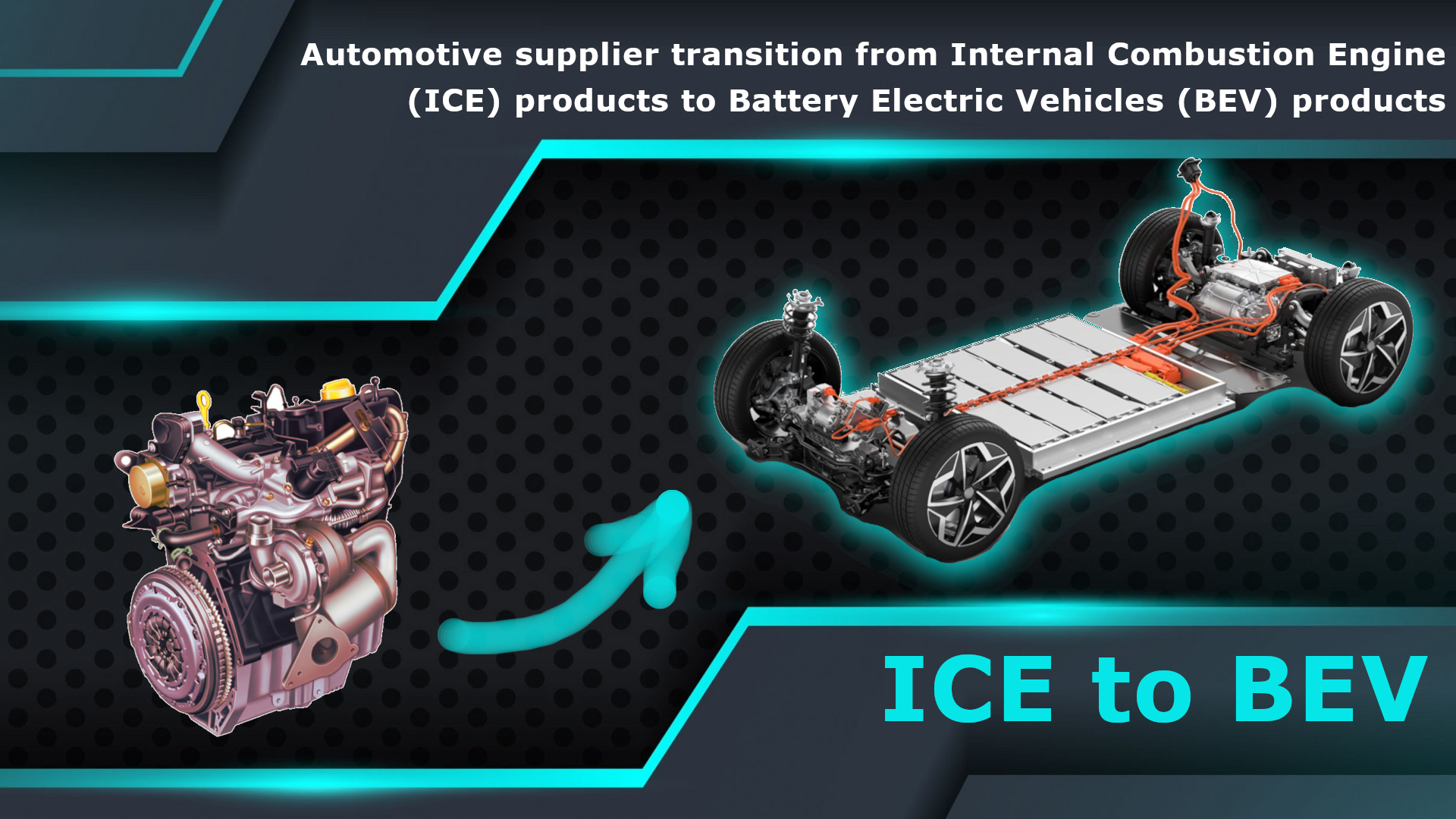Desired outcome
Given the shift towards electric cars and the inherent differences in their powertrains compared to internal combustion engines (ICE), certain components in the traditional ICE powertrain market may become obsolete. This poses a future risk for suppliers in this sector. The challenge is to pinpoint an opportunity that electric car manufacturers need and to develop a strategy to address this opportunity with a unique differentiator that sets the supplier apart from competitors.
Initial Problem Description
In the traditional internal combustion engine (ICE) powertrain market, suppliers have acquired specific knowledge and expertise related to the components they manufacture. Transitioning to the Battery Electric Vehicle (BEV) market may necessitate acquiring new knowledge, as some of the existing expertise may become obsolete. The most efficient transition from ICE components to BEV components occurs when the required knowledge for these new components aligns with the supplier's existing expertise.
Context
The context of the problem to be solved involves a supplier currently operating in the traditional Internal Combustion Engine (ICE) powertrain market. With the automotive industry moving towards Battery Electric Vehicles (BEVs), there is a recognition that certain components in the ICE powertrain may become obsolete. This shift poses a potential risk to the supplier's future viability. The challenge is to identify new opportunities in the BEV market and strategically address them, considering factors such as circularity, sustainability, Industry 4.0, and digitalization. Additionally, the supplier needs to navigate the transition by leveraging existing knowledge where applicable and acquiring new knowledge relevant to BEV components, ensuring a swift and efficient adaptation to the evolving automotive landscape.
Connection to cross-cutting areas
Circularity and sustainability should be an integral considerations in assessing every identified product opportunity.
Industry 4.0 and digitalization are crucial factors in the manufacturing processes of every T1 automotive supplier. Any new product opportunity must incorporate and address these two aspects.
Input
Increasing Range:
Advances in battery technology were leading to increased energy density and, consequently, longer driving ranges for electric vehicles.
Fast-Charging Infrastructure:
The expansion and improvement of fast-charging networks were addressing concerns about charging times, making electric vehicles more convenient for users.
Diversity in Model Offerings:
Automakers were expanding their electric vehicle portfolios, offering a wider range of models from compact cars to SUVs and even trucks.
Affordability and Cost Reduction:
Efforts were being made to reduce the cost of electric vehicles, making them more accessible to a broader consumer base. Government incentives were playing a role in this regard.
Advancements in Battery Technology:
Research and development in battery technology were ongoing, with a focus on improving performance, durability, and sustainability.
Integration of AI and Connectivity:
Artificial intelligence and advanced connectivity features were being integrated into electric vehicles for improved user experience, predictive maintenance, and enhanced autonomous capabilities.
Focus on Sustainability:
Both manufacturers and consumers were increasingly concerned about the environmental impact of electric vehicle production. Efforts were being made to enhance the sustainability of the entire lifecycle, including sourcing materials and recycling.
Regulatory Support:
Governments in various regions were implementing policies and regulations to encourage the adoption of electric vehicles. This included emission standards, incentives for manufacturers, and charging infrastructure development.
Collaborations and Partnerships:
Automakers and technology companies were forming strategic partnerships and collaborations to leverage each other's strengths in areas such as battery development, software integration, and autonomous driving.
Consumer Education and Acceptance:
Efforts were being made to educate consumers about the benefits of electric vehicles, dispelling myths and addressing concerns, to encourage wider adoption
Expectations
A self-initiated team with interchangeable communication, fostering a collaborative environment that encourages proactive engagement not only within the team but also with me. This dynamic emphasizes individual initiative, while the ability to adapt and interchange communication methods ensures effective and seamless interaction between team members and myself.
Desired Team Profile
A multifaceted team comprising business developers, forward-thinking individuals with a keen eye on the future, and skilled engineers. This collective brings together a diverse set of talents, combining the strategic acumen of business developers, the visionary perspective of future-minded individuals, and the technical expertise of engineers.
Additional Information
Automotive component suppliers in Europe are currently facing comparable challenges. A successful transition to future powertrain components is imperative for the broader European economy. The automotive industry plays a significant role, providing direct and indirect employment to 13 million Europeans, with 2.4 million jobs in manufacturing alone. The EU auto industry boasts an average production of 5.1 motor vehicles per worker. Hence, maintaining a robust European supply chain is crucial for the industry's sustained strength in the future.
Related Keywords
About Vasja Kutin
Hidria Advancetec. BU of Hidria d.o.o.. Based in Slovenia. 350 employees.
Suppliyng automotive OEMs with thermal management solutions and sensors.

You need to sign up to apply to this challenge and submit a motivation letter!

Learn more about the topics and find team members!
Help
Need help submitting your proposal or have questions regarding this Open Innovation Challenge?
Contact support

